Cambodian vs Norwegian Community Comparison
COMPARE
Cambodian
Norwegian
Social Comparison
Social Comparison
Cambodians
Norwegians
9,346
SOCIAL INDEX
90.9/ 100
SOCIAL RATING
19th/ 347
SOCIAL RANK
8,521
SOCIAL INDEX
82.7/ 100
SOCIAL RATING
68th/ 347
SOCIAL RANK
Norwegian Integration in Cambodian Communities
The statistical analysis conducted on geographies consisting of 101,741,797 people shows a slight negative correlation between the proportion of Norwegians within Cambodian communities in the United States with a correlation coefficient (R) of -0.077. On average, for every 1% (one percent) increase in Cambodians within a typical geography, there is a decrease of 0.095% in Norwegians. To illustrate, in a geography comprising of 100,000 individuals, a rise of 1,000 Cambodians corresponds to a decrease of 94.6 Norwegians.
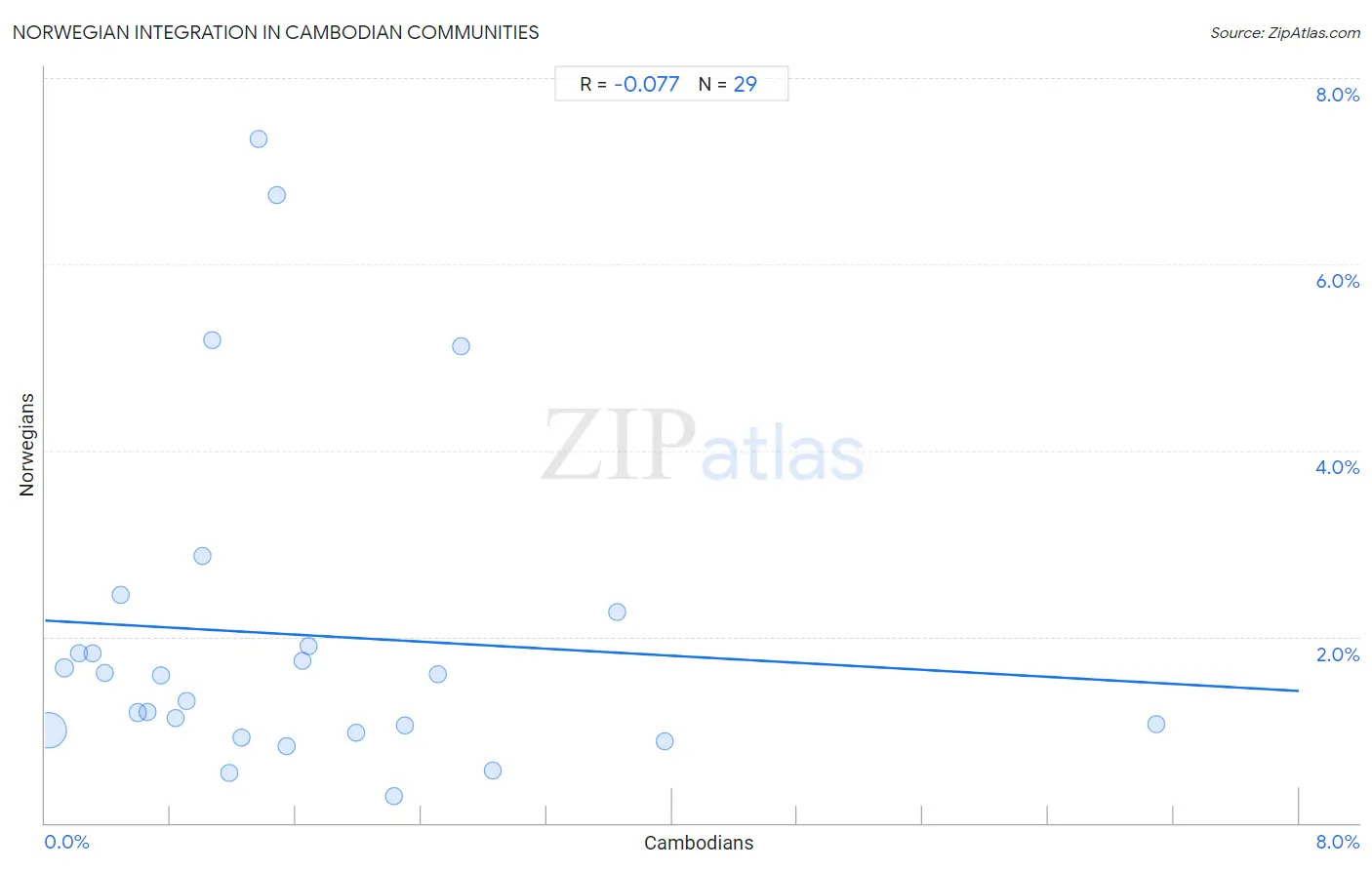
Cambodian vs Norwegian Income
When considering income, the most significant differences between Cambodian and Norwegian communities in the United States are seen in per capita income ($51,731 compared to $44,480, a difference of 16.3%), median female earnings ($45,014 compared to $38,802, a difference of 16.0%), and median earnings ($53,386 compared to $46,865, a difference of 13.9%). Conversely, both communities are more comparable in terms of householder income under 25 years ($55,571 compared to $53,127, a difference of 4.6%), householder income over 65 years ($66,892 compared to $61,104, a difference of 9.5%), and householder income ages 45 - 64 years ($114,342 compared to $103,682, a difference of 10.3%).

| Income Metric | Cambodian | Norwegian |
| Per Capita Income | Exceptional $51,731 | Good $44,480 |
| Median Family Income | Exceptional $117,780 | Excellent $106,144 |
| Median Household Income | Exceptional $96,324 | Good $86,084 |
| Median Earnings | Exceptional $53,386 | Good $46,865 |
| Median Male Earnings | Exceptional $62,516 | Excellent $55,965 |
| Median Female Earnings | Exceptional $45,014 | Poor $38,802 |
| Householder Age | Under 25 years | Exceptional $55,571 | Exceptional $53,127 |
| Householder Age | 25 - 44 years | Exceptional $107,148 | Good $96,866 |
| Householder Age | 45 - 64 years | Exceptional $114,342 | Excellent $103,682 |
| Householder Age | Over 65 years | Exceptional $66,892 | Average $61,104 |
| Wage/Income Gap | Average 25.8% | Tragic 29.0% |
Cambodian vs Norwegian Poverty
When considering poverty, the most significant differences between Cambodian and Norwegian communities in the United States are seen in married-couple family poverty (4.5% compared to 3.7%, a difference of 21.0%), seniors poverty over the age of 65 (10.4% compared to 8.7%, a difference of 20.0%), and seniors poverty over the age of 75 (12.0% compared to 10.2%, a difference of 18.1%). Conversely, both communities are more comparable in terms of child poverty under the age of 5 (14.4% compared to 14.6%, a difference of 1.4%), single father poverty (16.4% compared to 15.9%, a difference of 3.2%), and single mother poverty (27.0% compared to 28.4%, a difference of 5.3%).
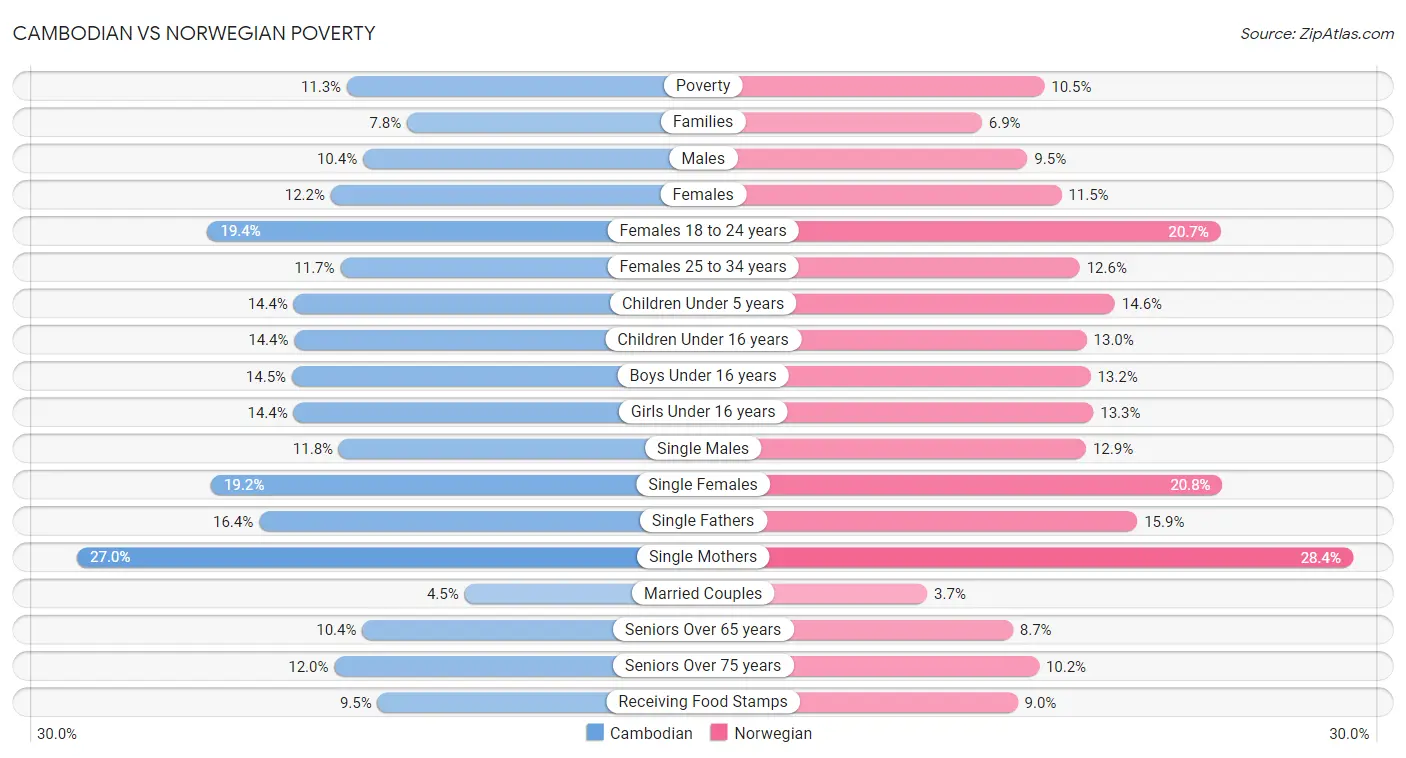
| Poverty Metric | Cambodian | Norwegian |
| Poverty | Exceptional 11.3% | Exceptional 10.5% |
| Families | Exceptional 7.8% | Exceptional 6.9% |
| Males | Exceptional 10.4% | Exceptional 9.5% |
| Females | Exceptional 12.2% | Exceptional 11.5% |
| Females 18 to 24 years | Exceptional 19.4% | Tragic 20.7% |
| Females 25 to 34 years | Exceptional 11.7% | Exceptional 12.6% |
| Children Under 5 years | Exceptional 14.4% | Exceptional 14.6% |
| Children Under 16 years | Exceptional 14.4% | Exceptional 13.0% |
| Boys Under 16 years | Exceptional 14.5% | Exceptional 13.2% |
| Girls Under 16 years | Exceptional 14.4% | Exceptional 13.3% |
| Single Males | Exceptional 11.8% | Fair 12.9% |
| Single Females | Exceptional 19.2% | Good 20.8% |
| Single Fathers | Fair 16.4% | Exceptional 15.9% |
| Single Mothers | Exceptional 27.0% | Exceptional 28.4% |
| Married Couples | Exceptional 4.5% | Exceptional 3.7% |
| Seniors Over 65 years | Excellent 10.4% | Exceptional 8.7% |
| Seniors Over 75 years | Good 12.0% | Exceptional 10.2% |
| Receiving Food Stamps | Exceptional 9.5% | Exceptional 9.0% |
Cambodian vs Norwegian Unemployment
When considering unemployment, the most significant differences between Cambodian and Norwegian communities in the United States are seen in unemployment among seniors over 75 years (7.6% compared to 9.8%, a difference of 28.0%), unemployment among women with children under 6 years (5.9% compared to 7.2%, a difference of 22.6%), and female unemployment (4.9% compared to 4.2%, a difference of 17.3%). Conversely, both communities are more comparable in terms of unemployment among ages 65 to 74 years (5.0% compared to 5.0%, a difference of 1.1%), unemployment among ages 25 to 29 years (5.8% compared to 6.0%, a difference of 2.5%), and unemployment among seniors over 65 years (4.8% compared to 4.7%, a difference of 3.0%).
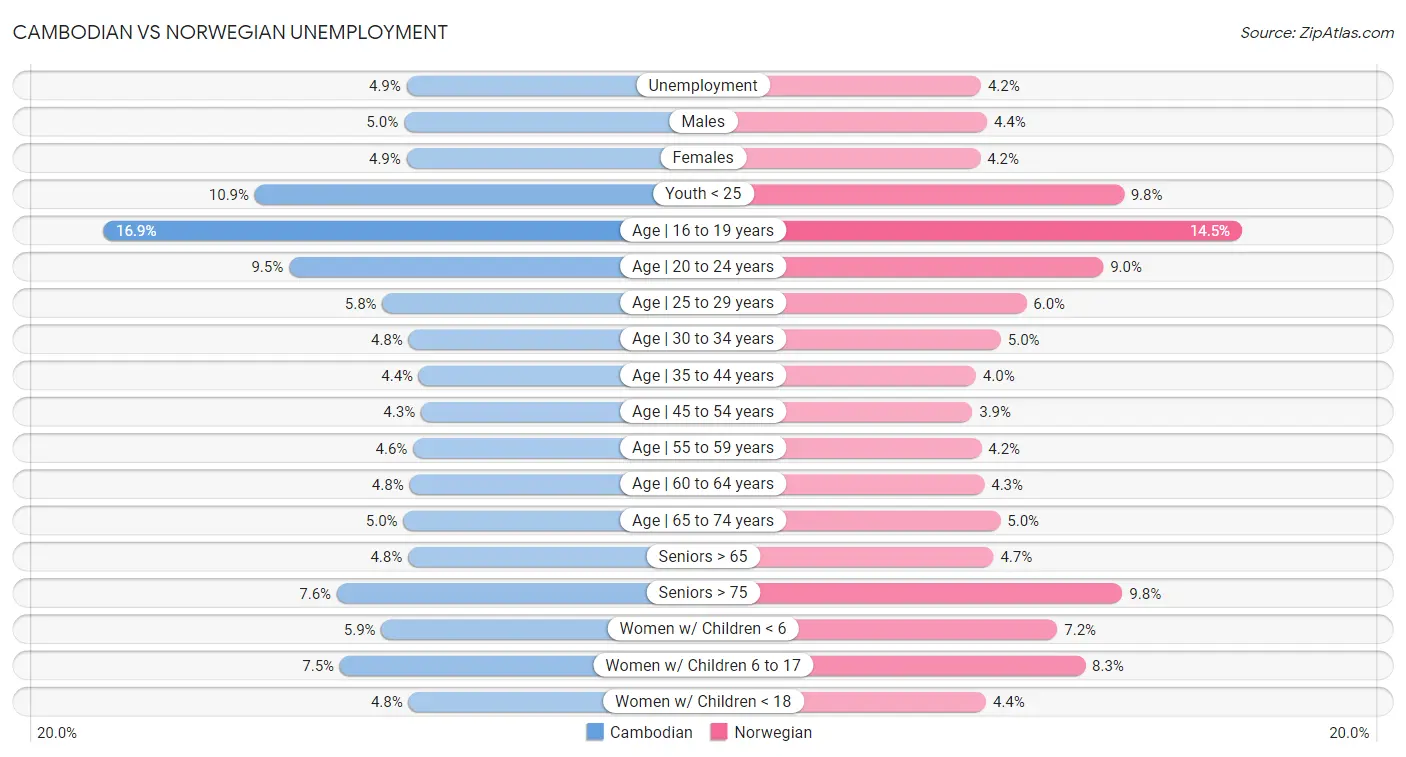
| Unemployment Metric | Cambodian | Norwegian |
| Unemployment | Exceptional 4.9% | Exceptional 4.2% |
| Males | Exceptional 5.0% | Exceptional 4.4% |
| Females | Exceptional 4.9% | Exceptional 4.2% |
| Youth < 25 | Exceptional 10.9% | Exceptional 9.8% |
| Age | 16 to 19 years | Exceptional 16.9% | Exceptional 14.5% |
| Age | 20 to 24 years | Exceptional 9.5% | Exceptional 9.0% |
| Age | 25 to 29 years | Exceptional 5.8% | Exceptional 6.0% |
| Age | 30 to 34 years | Exceptional 4.8% | Exceptional 5.0% |
| Age | 35 to 44 years | Exceptional 4.4% | Exceptional 4.0% |
| Age | 45 to 54 years | Exceptional 4.3% | Exceptional 3.9% |
| Age | 55 to 59 years | Exceptional 4.6% | Exceptional 4.2% |
| Age | 60 to 64 years | Excellent 4.8% | Exceptional 4.3% |
| Age | 65 to 74 years | Exceptional 5.0% | Exceptional 5.0% |
| Seniors > 65 | Exceptional 4.8% | Exceptional 4.7% |
| Seniors > 75 | Exceptional 7.6% | Tragic 9.8% |
| Women w/ Children < 6 | Exceptional 5.9% | Exceptional 7.2% |
| Women w/ Children 6 to 17 | Exceptional 7.5% | Exceptional 8.3% |
| Women w/ Children < 18 | Exceptional 4.8% | Exceptional 4.4% |
Cambodian vs Norwegian Labor Participation
When considering labor participation, the most significant differences between Cambodian and Norwegian communities in the United States are seen in in labor force | age 16-19 (37.0% compared to 46.2%, a difference of 24.8%), in labor force | age 20-24 (75.2% compared to 80.1%, a difference of 6.6%), and in labor force | age > 16 (67.4% compared to 65.7%, a difference of 2.7%). Conversely, both communities are more comparable in terms of in labor force | age 20-64 (81.1% compared to 81.0%, a difference of 0.12%), in labor force | age 25-29 (86.0% compared to 86.1%, a difference of 0.15%), and in labor force | age 35-44 (85.3% compared to 85.6%, a difference of 0.34%).

| Labor Participation Metric | Cambodian | Norwegian |
| In Labor Force | Age > 16 | Exceptional 67.4% | Exceptional 65.7% |
| In Labor Force | Age 20-64 | Exceptional 81.1% | Exceptional 81.0% |
| In Labor Force | Age 16-19 | Good 37.0% | Exceptional 46.2% |
| In Labor Force | Age 20-24 | Good 75.2% | Exceptional 80.1% |
| In Labor Force | Age 25-29 | Exceptional 86.0% | Exceptional 86.1% |
| In Labor Force | Age 30-34 | Exceptional 86.2% | Exceptional 85.7% |
| In Labor Force | Age 35-44 | Exceptional 85.3% | Exceptional 85.6% |
| In Labor Force | Age 45-54 | Exceptional 84.1% | Exceptional 84.4% |
Cambodian vs Norwegian Family Structure
When considering family structure, the most significant differences between Cambodian and Norwegian communities in the United States are seen in single father households (2.0% compared to 2.4%, a difference of 22.1%), births to unmarried women (26.7% compared to 29.3%, a difference of 10.0%), and divorced or separated (11.1% compared to 12.1%, a difference of 9.3%). Conversely, both communities are more comparable in terms of average family size (3.15 compared to 3.08, a difference of 2.3%), family households with children (26.5% compared to 27.4%, a difference of 3.1%), and single mother households (5.3% compared to 5.5%, a difference of 3.4%).

| Family Structure Metric | Cambodian | Norwegian |
| Family Households | Tragic 61.4% | Poor 63.9% |
| Family Households with Children | Tragic 26.5% | Fair 27.4% |
| Married-couple Households | Fair 45.9% | Exceptional 49.5% |
| Average Family Size | Tragic 3.15 | Tragic 3.08 |
| Single Father Households | Exceptional 2.0% | Poor 2.4% |
| Single Mother Households | Exceptional 5.3% | Exceptional 5.5% |
| Currently Married | Good 47.0% | Exceptional 50.2% |
| Divorced or Separated | Exceptional 11.1% | Fair 12.1% |
| Births to Unmarried Women | Exceptional 26.7% | Exceptional 29.3% |
Cambodian vs Norwegian Vehicle Availability
When considering vehicle availability, the most significant differences between Cambodian and Norwegian communities in the United States are seen in no vehicles in household (10.9% compared to 6.4%, a difference of 69.3%), 4 or more vehicles in household (5.5% compared to 8.0%, a difference of 45.7%), and 3 or more vehicles in household (17.8% compared to 23.9%, a difference of 34.5%). Conversely, both communities are more comparable in terms of 1 or more vehicles in household (89.2% compared to 93.7%, a difference of 5.1%), 2 or more vehicles in household (53.3% compared to 62.8%, a difference of 18.0%), and 3 or more vehicles in household (17.8% compared to 23.9%, a difference of 34.5%).

| Vehicle Availability Metric | Cambodian | Norwegian |
| No Vehicles Available | Poor 10.9% | Exceptional 6.4% |
| 1+ Vehicles Available | Poor 89.2% | Exceptional 93.7% |
| 2+ Vehicles Available | Tragic 53.3% | Exceptional 62.8% |
| 3+ Vehicles Available | Tragic 17.8% | Exceptional 23.9% |
| 4+ Vehicles Available | Tragic 5.5% | Exceptional 8.0% |
Cambodian vs Norwegian Education Level
When considering education level, the most significant differences between Cambodian and Norwegian communities in the United States are seen in master's degree (20.0% compared to 14.0%, a difference of 42.4%), professional degree (6.0% compared to 4.2%, a difference of 42.4%), and no schooling completed (1.9% compared to 1.3%, a difference of 40.9%). Conversely, both communities are more comparable in terms of nursery school (98.2% compared to 98.7%, a difference of 0.60%), kindergarten (98.1% compared to 98.7%, a difference of 0.61%), and 1st grade (98.1% compared to 98.7%, a difference of 0.62%).
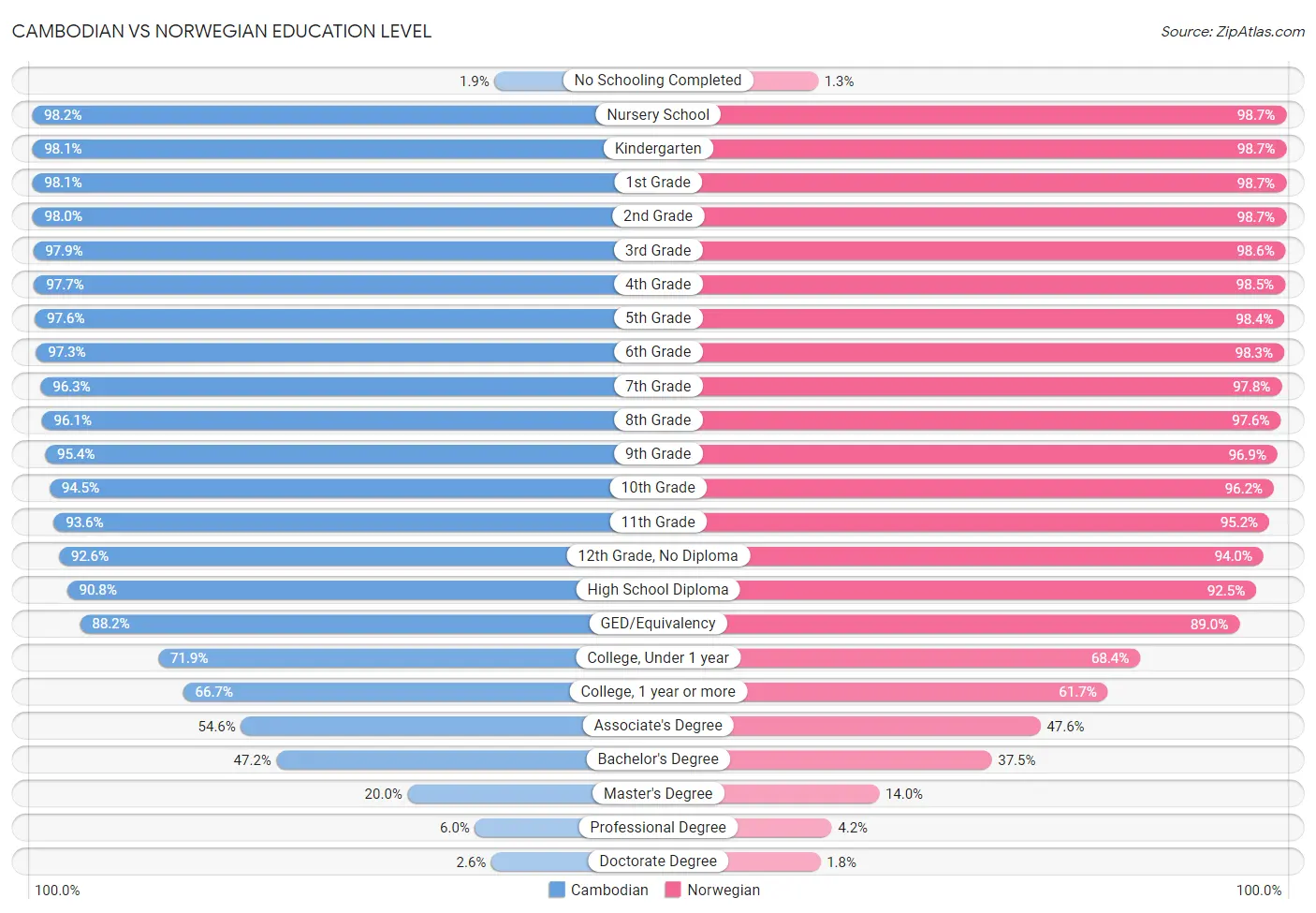
| Education Level Metric | Cambodian | Norwegian |
| No Schooling Completed | Exceptional 1.9% | Exceptional 1.3% |
| Nursery School | Exceptional 98.2% | Exceptional 98.7% |
| Kindergarten | Exceptional 98.1% | Exceptional 98.7% |
| 1st Grade | Exceptional 98.1% | Exceptional 98.7% |
| 2nd Grade | Exceptional 98.0% | Exceptional 98.7% |
| 3rd Grade | Excellent 97.9% | Exceptional 98.6% |
| 4th Grade | Excellent 97.7% | Exceptional 98.5% |
| 5th Grade | Exceptional 97.6% | Exceptional 98.4% |
| 6th Grade | Exceptional 97.3% | Exceptional 98.3% |
| 7th Grade | Excellent 96.3% | Exceptional 97.8% |
| 8th Grade | Exceptional 96.1% | Exceptional 97.6% |
| 9th Grade | Exceptional 95.4% | Exceptional 96.9% |
| 10th Grade | Exceptional 94.5% | Exceptional 96.2% |
| 11th Grade | Exceptional 93.6% | Exceptional 95.2% |
| 12th Grade, No Diploma | Exceptional 92.6% | Exceptional 94.0% |
| High School Diploma | Exceptional 90.8% | Exceptional 92.5% |
| GED/Equivalency | Exceptional 88.2% | Exceptional 89.0% |
| College, Under 1 year | Exceptional 71.9% | Exceptional 68.4% |
| College, 1 year or more | Exceptional 66.7% | Exceptional 61.7% |
| Associate's Degree | Exceptional 54.6% | Excellent 47.6% |
| Bachelor's Degree | Exceptional 47.2% | Average 37.5% |
| Master's Degree | Exceptional 20.0% | Poor 14.0% |
| Professional Degree | Exceptional 6.0% | Fair 4.2% |
| Doctorate Degree | Exceptional 2.6% | Average 1.8% |
Cambodian vs Norwegian Disability
When considering disability, the most significant differences between Cambodian and Norwegian communities in the United States are seen in disability age under 5 (1.2% compared to 1.7%, a difference of 45.2%), hearing disability (2.8% compared to 3.7%, a difference of 30.3%), and disability age 18 to 34 (6.2% compared to 7.6%, a difference of 23.8%). Conversely, both communities are more comparable in terms of disability age over 75 (46.1% compared to 45.5%, a difference of 1.3%), self-care disability (2.2% compared to 2.3%, a difference of 2.3%), and disability age 65 to 74 (21.8% compared to 22.5%, a difference of 3.3%).
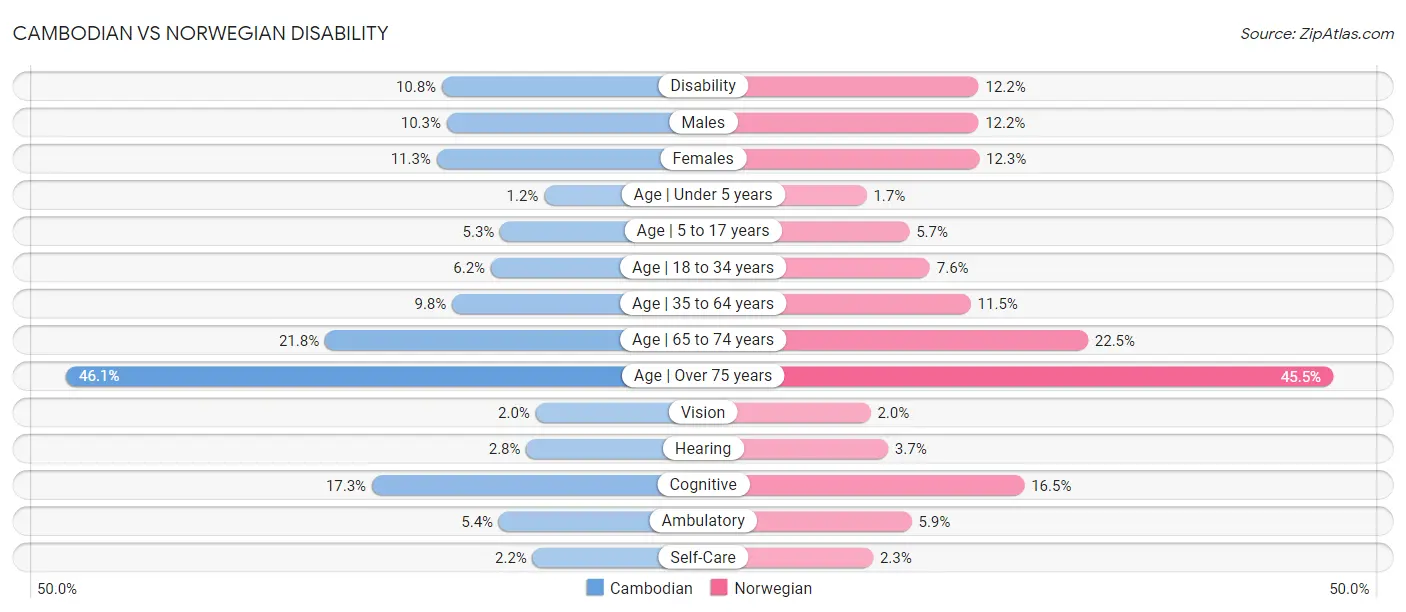
| Disability Metric | Cambodian | Norwegian |
| Disability | Exceptional 10.8% | Tragic 12.2% |
| Males | Exceptional 10.3% | Tragic 12.2% |
| Females | Exceptional 11.3% | Fair 12.3% |
| Age | Under 5 years | Exceptional 1.2% | Tragic 1.7% |
| Age | 5 to 17 years | Exceptional 5.3% | Fair 5.7% |
| Age | 18 to 34 years | Exceptional 6.2% | Tragic 7.6% |
| Age | 35 to 64 years | Exceptional 9.8% | Fair 11.5% |
| Age | 65 to 74 years | Exceptional 21.8% | Exceptional 22.5% |
| Age | Over 75 years | Exceptional 46.1% | Exceptional 45.5% |
| Vision | Exceptional 2.0% | Exceptional 2.0% |
| Hearing | Exceptional 2.8% | Tragic 3.7% |
| Cognitive | Fair 17.3% | Exceptional 16.5% |
| Ambulatory | Exceptional 5.4% | Exceptional 5.9% |
| Self-Care | Exceptional 2.2% | Exceptional 2.3% |